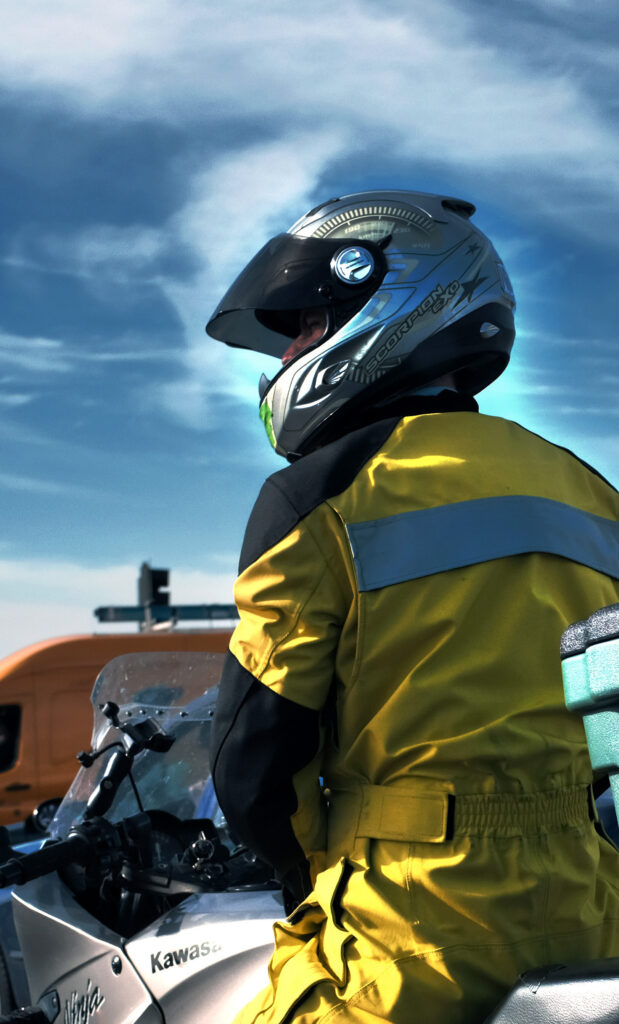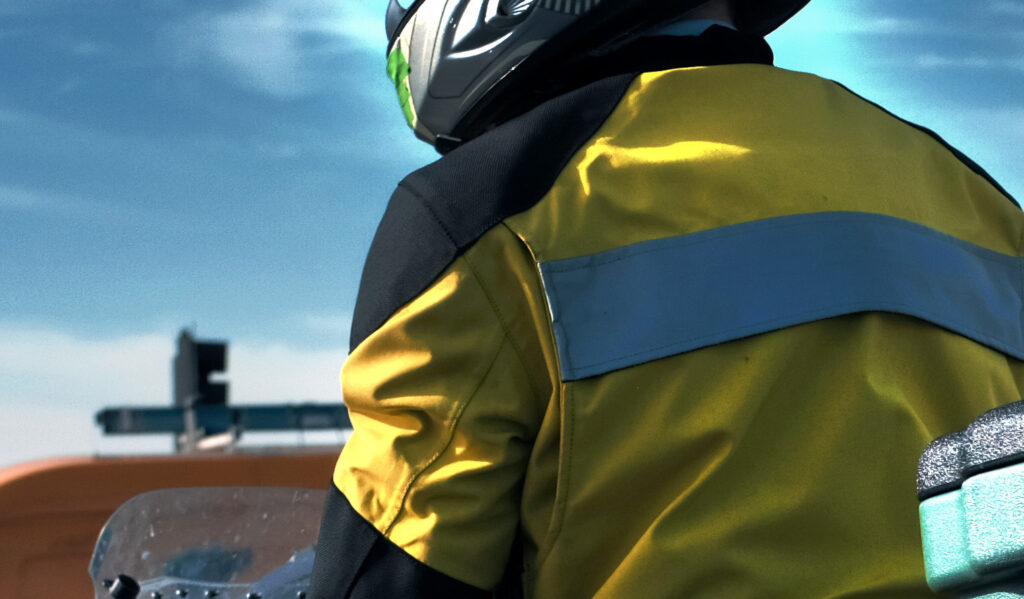I’m sure you’ve seen them. The moto-commuters that come in from their place out in the sticks, putting in 75 miles each way to get to the office each day. Often in one of several highly visible colors, and often enough in a garish combination offending the sensibilities and optic nerves of anyone they encounter. Even when most of us are pondering working from home or instead whether we need an ark to get to work, these riders arrive with a smile on their faces and a wry joke around dodging the cats and dogs. We’ll delve into the various benefits and compromises that one-piece riding suits entail and whether it may be right for you.
No doctor consultation required!
Benefits

ATTGAT
One-piece riding suits have one unexpected benefit, you’re not going to go anywhere wearing half the suit because the grocery store or office is “just around the corner”. You’ll have All The Gear, All The Time with a one-piece suit. And if the unfortunate but not unforeseen happens, you’ll have armor and abrasion resistant material in all the correct places.
Sizing
Speaking of the correct places, one-piece suits are the offerings most likely to be offered in custom sizes. Custom suits offered in an array of chest, waist, leg, and sleeve sizes ensure that your suit fits its best. As an owner of several suits, I affirm that a suit that fits exactly right adds an extra layer of enjoyment. While it may not seem like much, that came make unpleasant commutes much better.
If you’re a movie-goer of the past few years, you might’ve seen one of the comic-book-based franchises where the protagonist wear a big power suit that assembles around the rider. Finding the motorcycle suit that best suits you feels a lot like that. Being able to run a zipper or two from neck to ankle and not need to sit down is marvelous. Indeed, one can simply walk into a premium-tier one-piece motorcycle suit.
Pain Points of A One-Piece Riding Suit
As with all riding apparel, certain truths are self-evident. Motorcycles take us out into the weather. Most motorcycle commuting involves bending at the hips. Even if you’re in Southern California, you’re bound to eventually ride in the rain. And if you ride in the rain, you’ll probably encounter puddles collecting in the folds your suit.
Gore-Tex™ and similar materials are great at shuffling moisture out through fabric, but that won’t help when there’s a puddle on the outside. You’ll need to find a suit that works well with your body shape and doesn’t cause puddling with excess material around your middle.
All this flash and function doesn’t come cheap either. While you can find very affordable prices of separate jacket and pants combinations, finding a smoking hot deal on a one-piece suit is a far less common occurrence. Much more thought and engineering has to go into building a one-piece, and those specialized skills are less likely to be sitting on the bench waiting in the overseas factories used by the discount motorcycle gear manufacturers. Indeed, the best suits are hand-sewn by experienced seamsters.
As mentioned at the top, one-piece suits aren’t exactly haute couture. Even the best textile suits look a bit clunky and walking around in a full fitted leather suit is more than a bit weird in an office environment. Carrying or keeping a change of clothes for the office or finding an out of the way place to store your riding suit during the business day might make your daily commute a little less of a topic of conversations among your office-mates.
Caveats & Useful Features
To the beginner there may be some confusion between one-piece rain suits and one-piece riding suits. Rain suits usually are single-layer nylon is quite water-resistant but not very breathable. These suits have neither armor nor liner, and are not meant to be protective gear. One-piece riding suits are what we’ve described earlier in this article, usually made of leather or a heavy-gauge nylon fabric. These suits will have soft or hard armor, and often an inner comfort liner for warmth or additional water resistance.
Pockets
One very handy feature is waterproof exterior pockets. It’s a royal pain to have to fish your wallet out from inside your suit to gas your bike up, and it’s even more gross to have to deal with a sodden wallet. You can prevent both of these annoyances by finding a suit with waterproof exterior pockets to stash water-sensitive items like wallets, phones, or GoPro cameras.
One-piece suits that have been thoughtfully designed have passthrough pockets to allow you to reach through to get your wallet or house keys or to pass the cord for your heated vest liner through. Cheaper suits won’t have this, and you’ll need to take scissors and cut an opening in your pocket liner to feed a cord through.
Rain Collars & Armor
Jackets and suits designed for inclement weather will have a collar that seals firmly against the neck, but have a soft liner to prevent abrasion. Once called “Mandarin collars”, these colors keep cold draft and blown spray from rolling down your neck and into your gear.
Suits that have been thoughtfully designed will also have adjustable armor positioning. This may involve a set of buttons or position-able Velcro strips, but all should allow your to move the joint armor to the position that fits your body best. While it may appear obvious to the veteran rider, make sure you check the armor positioning while sitting on your bike in standard riding position. The outside circumference of all of those joints will be vastly different from when you’re standing in the store of your living room.
Lined vs Unlined Riding Suits
Some manufacturers of riding suits offer models with or without an interior comfort liner. These have a number of drawbacks and advantages based on your style of riding, even within the narrower confines of motorcycle commuting.
Liner-less suits that provide no armor but instead provide abrasion resistance and water-resistant performance . These suits aren’t useless however. They can be paired up with a street-riding armored endo-skeleton rig or an off-road bash plate combination, for example. Riders who primarily ride dirt might prefer this combination as it’s closer to their usual riding gear.
Hypalon & Gore-Tex
Most one-piece riding suits are constructed with a durable water resistant fabric. The two most common are W. L. Gore & Associates’ Gore-Tex fabric or DuPont’s Hypalon. The heavier gauge fabrics here will have better abrasion resistance, and more-expensive suits will have heavy gauge fabric in the shell and not just the joints.
Alternatively, the Aerostich company makes a weather-resistant leather riding suit. With features much like the more-common textile suits, they’re an excellent choice if you don’t care for the nature of rough nylon textile riding gear.
Construction
As might be expected, one of the key price differentiators in riding suits is the cost of labor to construct them. Less expensive suits that don’t come in custom sizing are more likely to have much more of the suit hand-constructed. Some manufacturers work almost entirely by hand, such as Aerostich while others do more machine cuts and instead charge additional for custom work.
Riding Styles
One overlooked aspect of one-piece riding suits is that they’re often built for a specific purpose. Sport-riding suits and Touring suits will have different assumptions about the body form while riding. Sport-riding suits have a longer section in the lower back to account for forward lean, and will have arm connections that are rotated further forward to account for the sportbike “drape” across the tank.
Similarly, Adventure suits will be designed to work better than other types when riding standing-up. These suits may have less armor or room beneath the outer shell for motocross pads. This hides a certain fallacy built into motorcycle tough. It’s certainly true that falling in the dirt hurts less than concrete. However, you’ll still want CE-rated armor for commuting duty regardless of how it fits into your gear or on your body.
Research & Shopping Suggestions
We recommend contacting the manufacturer to determine a suit’s riding style when researching. Not all suits are alike, and many have a specific focus in mind or require adjustments. Case in point, Aerostich offers a sewn-in ellipse for forward lean to accommodate sport-riding. Make sure a suit’s vendor can describe the intended riding style for a suit, otherwise keep looking.
If you’re shopping in person, look for a bike similar to yours in the showroom. If you can try on a suit, spend 15-20 minutes sitting on in the proper position on a bike. Preferably this should be on a motorcycle with a centerstand. If you don’t need to hold the motorcycle up, you can position your hips in riding position.
Maintenance For Your Riding Suit
While I can at best provide general care advice, first consult the care instructions for your suit or check with the suit manufacturer’s website. Some suits will be fine with certain chemicals, and others will be ruined. Check carefully on small unimportant areas for any new cleaner. Likewise, you can throw some suits in the washer where others require handwash or dry-clean. Check your care instructions before cleaning, and use good judgment.
Where To Find A Suit
In no particular order, here are a number of well-known vendors that sell one-piece riding suits.
Aerostich
Aerostich is the granddaddy and the arguable progenitor of the modern water-resistant textile riding suit. Based out of Duluth, Minnesota, USA, Aerostich prides themselves on offering custom riding suits cut, sewn, and shipped from their own local facility. I can directly attest to the quality, as I’ve owned and crash-tested an Aerostich Roadcrafter jacket While mine is not very waterproof after 18 years, it’s still plenty strong for adventure riding duty.
Aerostich focuses strictly on on-road motorcycling. Their Roadcrafter suits have a particular reputation for quick donning or removal, with notable popularity with long-distance riders.
Klim
Based out of Rigby, Idaho, Klim (pronounced like ‘Climb’) is a manufacturer of motorcycle, general motorsports, and outdoor gear. Klim offers a wide variety of high-quality gear, many tailored to off-road riding. Accordingly, they’re a favorite of several of my friends who ride BMW GS and Touring models. Purchased by Polaris, Inc. in 2012, Klim still operates a significant presence in Eastern Idaho. If you make it out to their factory showroom, it’s near some of the best off-roading and winter sports areas in North America.
Motoport USA
Motoport is a gear manufacturer originally based out of the EU. After several changes, they are now a private venture in Southern California. Motoport is the only vendor in this list to have their entire catalog of suits and jackets available solely by custom order, all manufactured in their facility outside Escondido, California. Their suits are also surprisingly customizable with over a dozen options available on the suits that I saw available.
Other Options
Motorcycle gear manufacturers such as Dianese, Cortech, Joe Rocket, Revit, Held, and Firstgear also offer one-piece riding suits. These are more often available through large online or distributors to your local motorcycle shop or dealership, and as of this time some of these vendors only offer leather racing suits. Keep an eye on these vendors for new offerings incorporating the benefits described in this series.
